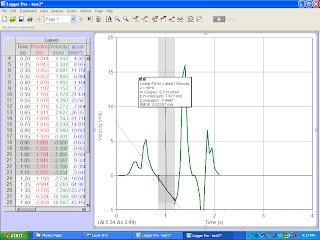Purpuse of graph : To determin the acceleration for a freely falling object.
: To gain experience in the computer as a data collection.
Object : ball
Equipment Used : windows based computer, Lab pro interface,Logger Pro software,motion detector,rubber ball,wire basker.
What we did: Loaded logger pro software on the position vs time graph. We changed the verical scale from 0 to 4 m and the horizontal scale or time to 0 to 4 seconds. We placed the motion detector on the floor facing upward and placed wire basket over the detector. After setting up the motion detecor we started the testing. Giving the ball a toss up about 1 meter above the detector. After a few tosses we obtained a graph with a parabol showing the balls motion going up and down. Graph located in Ex: 1. We then selected the ata in the interval that corresponds to the free falling motion of the ball. Then we choose analyze/curve fit from the menu at the top of the menu. We selected at2+bt+c (quadratic) and then selected Try Fit obtaning the values for a,b,and c. To find the acceleration,gexp, of the ball from this data and to calculate the precent diffrence between the value obtained and the one accepted value,gecc,(9.80m/s2) we did the following equations
At2+Bt+C where A=( value obtain from table)
( 1/2
Percent = (measured-actual/measured) x100%
liner fit = mt+b
UNIT ANALYSIS
G expected = (2(4.9071m/s^(2)))= 9.814 m/s^(2)
% difference = ((9.814m/s^(2)-9.800m/s^(2))/9.800m/s^(2))x(100%)=.1429%
G expected(m)=-9.500m/s^(2) from graph
% difference=((9.500m/s^(2)-9.800m/s^(2))/(9.80m/s^(2))x(100%)= -3.060%
DIMENSIONAL ANALYSIS
G expected= 2(m/s^(2))= x m/s^(2)
%difference=( [m/s^(2)-m/s^(2)]/[m/s^(2)])*100%= x%
G expected(m)= m/s^(2) from graph
%difference= ([m/s^(2)- m/s^(2)]/m/s^(2))100% = x%
liner fit = mt+b
UNIT ANALYSIS
G expected = (2(4.9071m/s^(2)))= 9.814 m/s^(2)
% difference = ((9.814m/s^(2)-9.800m/s^(2))/9.800m/s^(2))x(100%)=.1429%
G expected(m)=-9.500m/s^(2) from graph
% difference=((9.500m/s^(2)-9.800m/s^(2))/(9.80m/s^(2))x(100%)= -3.060%
DIMENSIONAL ANALYSIS
G expected= 2(m/s^(2))= x m/s^(2)
%difference=( [
G expected(m)= m/s^(2) from graph
%difference= ([m/s^(2)- m/s^(2)]/m/s^(2))100% = x%
The following are the graphs that we made based on the 5 trials made:
VELOCITY VS. TIME
Here is are result tabel for the fallowing 5 trials.
| Reslults from From Falling Body Experiment | ||||||||
| Trials | gexp(2a)(m/s^(2)) | %diff | gexp(m)(m/s^(2)) | %diff | ||||
| 1 | 9.814 m/s^(2) | 0.143 | 9.5 | m/s^(2) | 3.06 | |||
| 2 | 9.612 m/s^(2) | 2.04 | 9.514 | m/s^(2) | 2.917 | |||
| 3 | 9.860 m/s^(2) | 0.61 | 9.528 | m/s^(2) | 2.78 | |||
| 4 | 9.541 m/s^(2) | 2.65 | 9.497 | m/s^(2) | 2.24 | |||
| 5 | 9.170 m/s^(2) | 6.42 | 9.532 | m/s^(2) | 2.73 | |||
POSITION VS TIME
My conclusion is that based on the graphs including Velocity vs. Time and Position vs.Time and are calculaions shown on the table. Given the gravity was 9.80 m/s^(2) and most of are calculation wher 0.3 to 0.2 off are graph show a accurate representaio of the ball in freefall motion. And because the velocity is equal to the gravity becaus there is no other force applied it. And because are experimen show that ar g obtained was on the average 9.500 m/s^(2) are percent diffrence was 2%. Becasue of this we obtained the results expected for the acceleratin for a free folling object in are graphs.





